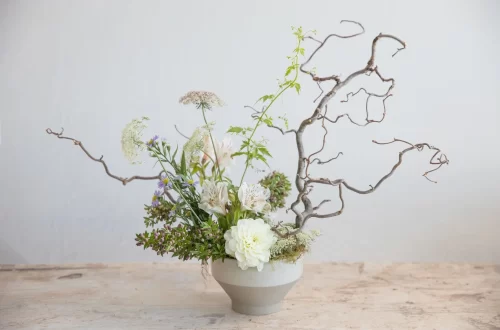
Shibori: A Timeless Japanese Dyeing Technique
 Dive into the Artistic World of Shibori
Dive into the Artistic World of Shibori
Shibori, a captivating form of Japanese manual tie-dyeing, is more than just a way to add color to fabric. It’s an art form that produces stunning patterns through a meticulous process of folding, twisting, stitching, clamping, or compressing fabric before dyeing it. The word “shibori” itself comes from the Japanese verb root “shiboru,” meaning “to wring, squeeze, or press,” hinting at the hands-on nature of this technique.
This Japanese technique dates back to the 8th century. Traditionally, a white cloth (usually silk, hemp, or cotton) was folded, bunched, or twisted, then tied, and finally dipped into a natural indigo dye. Over the centuries, artisans have developed many methods. In “arashi,” the cloth is wrapped around a pole to result a striated pattern that mimics heavy rain from a storm; in “itajime,” the cloth is folded accordion style and then held in place with two sturdy pieces of wood to result in geometric grids; in “kumo,” the cloth is tightly bound into tiny pleats to result in a series of spindly spiderwebs. These are some of the more popular styles, and there are other techniques like them. Each one results in a different design, although it can be argued that no two dyed pieces come out the same.
Endless Design Possibilities
The beauty of shibori lies in its versatility. By manipulating the fabric in various ways, artisans can achieve an incredible range of patterns, from geometric shapes and stripes to organic forms and intricate designs. Some of the most popular shibori techniques include:
- Kanoko shibori: Creates small circles or dots by bunching the fabric and tying it with thread.
- Arashi shibori: Arashi, translated in Japanese, means “storm.” This pole-wrapping technique produces a striated pattern that is reminiscent of stormy rain.
- Itajime shibori: Itajime is a shape-resist technique using wooden boards and blocks that produces bold geometric shapes like triangles and squares.
- Kumo shibori: Kumo, translated in Japanese, means “cloud.” This pleat and bind technique produces a spider-like ringed pattern.
- Miura shibori: Involves folding the fabric into intricate pleated configurations.
- Ne-maki shibori: Ne-maki is a technique that involves wrapping fabric around found objects and cinching them to produce small rings.
A Spectrum of Colors
Traditionally, shibori employed natural dyes, with indigo being the most popular choice. Indigo lends a beautiful blue hue to the fabric, but modern shibori artists have embraced a wider color palette. From vibrant yellows and fuchsias to earthy greens and browns, the color choices allow for even more creative expression.
Beyond Fabric
While shibori is most commonly used to create stunning textiles for clothing, upholstery, and home decor, its applications extend far beyond. The eye-catching patterns can be found on everything from lampshades and bags to wall art and jewelry.
Experience the Allure of Shibori
Whether you’re a textile enthusiast or simply appreciate beautiful craftsmanship, shibori offers a glimpse into a rich artistic tradition. Consider trying your hand at this captivating technique, or seek out shibori-inspired pieces to add a touch of timeless elegance to your wardrobe or home.
For those who want to delve deeper, there are numerous resources available online and in libraries that provide detailed instructions on different shibori methods. You can also find workshops and classes offered by textile artists who can guide you through the process. With a little practice, you can create your own unique shibori masterpieces!





